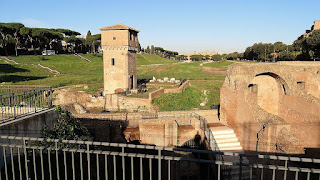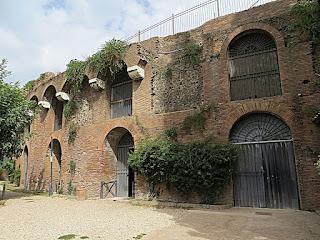Brief reign marked by gluttony and ineptitude
Aulus Vitellius, the third leader of Rome in the so-called Year of the Four Emperors, who history remembers mainly as a glutton, drunkard and gambler, died on this day in 69AD in Rome.
Vitellius had a reputation
for extravagance
Captured by supporters of his successor, Vespasian, he was dragged through the streets of the capital to the Scalae Gemoniae - the Gemonian Stairs - a flight of steps leading from the Capitoline Hill to the Forum that acquired a symbolic identity as a place of execution, where he was beaten to death.
Vitellius had been emperor for just eight months, his death bringing to an end a period of civil war that brought the death of Nero, followed by the chaos of three short-lived administrations before Vespasian’s accession restored order and ushered in a decade of relative stability.
Born in 15AD in Nuceria Alfaterna - now the Campanian town of Nocera Superiore - Vitellius was the son of Lucius Vitellius, a censor in the employ of the emperor Claudius who served as a consul three times and was a former governor of Syria.
Vitellius spent most of his youth on Capri as a noble companion of the retired Emperor Tiberius. He found favour with successive emperors in Caligula, though chariot racing, Claudius, who admired his dice playing, and Nero, whom he would flatter at public events by persuading him to sing and play the lute.
This enabled Vitellius to secure prestigious appointments such as Minister of Public Works and governor-general of Africa.
.jpg) |
| The emperor Caligula was among those Vitellius befriended |
He acquired virtually no military experience, so it came as a surprise when Galba, who had succeeded Nero as emperor, appointed him to be governor of Germania Inferior in 68. Suetonius speculated that Galba had reasoned that Vitellius, consumed by his addiction to excess, would be satisfied with the wealth and prestige that came with the appointment and pose no threat to his power.
The Germanic armies, however, saw things differently. They took to Vitellius, who made himself popular with his generosity and scant attention to discipline, and saw an opportunity to seize power from Galba, with whom they shared a mutual distrust.
Led by Caecina and Fabius Valens, commanders of two legions on the Rhine, organised a revolt. At the beginning of 69, they refused to renew their vows of allegiance to Galba and, in Cologne, proclaimed Vitellius as emperor.
Galba was killed shortly afterwards by members of the Praetorian Guard. He had refused to pay their bonuses and was in the habit of imposing heavy fines on or vengefully destroying towns that did not declare their allegiance to him and it did not take much in the way of bribes from Marcus Salvius Otho, a military commander with his eyes on power, to persuade them to murder him.
The Germanic armies remained intent on installing Vitellius as emperor in Rome nonetheless and, with the support of the armies of Gaul, Britannia and the central province of Raetia, marched on the capital.
_cropped.jpg) |
| Vespasian built a powerbase in the eastern empire before marching on Rome |
Roman historians were not united in their assessment of Vitellius’s term in office. While Suetonius described him as an unambitious leader whose time was dominated by his taste for luxury and vengeful cruelty, and pushing the imperial treasury close to bankruptcy, other historians, such as Tacitus, credit him with worthwhile and lasting changes to the way the empire was governed.
Moreover, he won favour with Rome’s lower classes by restoring the entertainments for the masses that had made Nero popular.
However, while Vitellius was recognised as emperor in Rome, the picture elsewhere was different.
The eastern provinces proclaimed a rival emperor in their commander, Titus Flavius Vespasianus, who had the support of the armies of the East, Dalmatia and Illyricum. Vespasian, as he was known, had been a military leader during the invasion of Britain in 43AD and built a powerbase following his appointment by Nero as commander in Judea, charged with quelling the Great Jewish Revolt of 67AD.
Vitellius despatched several legions, led by Caecina, only for Caecina, who had become unhappy with Vitellius's indisciplined conduct, to attempt to defect. This undermined the morale of the Vitellian troops and they were badly defeated at the Second Battle of Bedriacum.
Fearing his imminent downfall as Vespasian’s army headed towards Rome, Vitellius was said to have agreed on the terms of abdication with Marcus Antonius Primus, the military commander of Vespasian's forces. But the Praetorian Guard refused to allow him to sign the agreement.
Instead, a fierce battle ensued, with the mainly civilian supporters of Vitellius attacking Vespasian’s soldiers with rocks, javelins and heavy tiles ripped from walls and floors. Many buildings were destroyed and casualties from both sides combined may have exceeded 50,000.
Eventually, however, Vitellius was captured, dragged through the streets to meet his fate on the Scalae Gemoniae, his severed head then paraded around the city. Vespasian was pronounced emperor the next day and would rule for 10 years.
Travel tip:
A 19th century painting
of Vitellius's last moments
The Gemonian Stairs were a flight of steps in ancient Rome which acquired an infamous reputation in Roman history as a place of execution, earning the nickname the Stairs of Mourning. They led from Capitoline Hill down to the Roman Forum, passing the Tabularium and the Temple of Concord on one side, and the Mamertine Prison on the other. The location of the steps is thought to coincide roughly with the current Via di San Pietro in Carcere, which passes the ruins of the Mamertine Prison. It is believed they became a place of execution during the later years of the reign of Tiberius. It was customary for the condemned to be strangled before their bodies were left to rot, the remains picked at by birds and dogs before being thrown in the Tiber. Those executed were usually common criminals, their undignified end intended to heap shame on their families. Apart from Vitellius, the most high profile individual to be slain there was probably Lucius Aelius Sejanus, who was Prefect of the Praetorian Guard under Tiberius. He was executed for treason, suspected of conspiracy to kill his employer.
Travel tip:
The remains of a Roman necropolis
discovered near Nocera Superiore
The birthplace of Vitellius, Nuceria Alfaterna, evolved over time into the present day Nocera Superiore, a town in the province of Salerno in Campania. It can be found just off the main highway connecting Naples, about 42km (26 miles) to the northwest, with Salerno, about 15km (nine miles) to the southeast. The railway line between those two cities also passes through Nocera Superiore. The town is about 21km (13 miles) from the ruins of Pompeii. It suffered serious damage when Vesuvius erupted in 79AD, which while not as catastrophic as that inflicted on some of its neighbours was enough to cause irreparable harm to its prosperity. Among the ruins in the town are those of an Hellenistic-Roman theatre and a monumental Roman necropolis, offering a glimpse into ancient Roman burial practices. Remains also exist of an amphitheatre unearthed as recently as 1926 and city walls that date back to the 2nd century BC.
Also on this day:
1676: The birth of San Leonardo da Porto Maurizio
1856: The death of Sicilian patriot Francesco Bentivegna
1947: The birth of singer and TV presenter Gigliola Cinquetti
1948: The birth of journalist Giuliana Sgrena
.jpg)
.jfif)


.jpg)




.jpg)
















